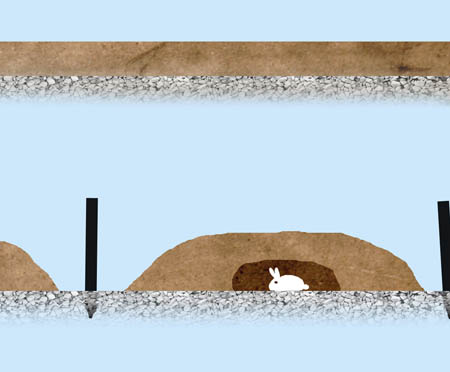A
NOTE ON PILLOW MOUNDS
 The means by which a rocky ground can be converted for rabbit farming is
illustrated in the figure. The upper diagram shows a layer of soil (brown)
over a rocky substrate which rabbits are unable to dig. For farming, the
soil is drawn into heaps so that patches of ground covered by soil, ie. the
"pillows", are separated by strips of rocky ground. A series of stakes are
driven into the rocky part to support isolating fences - as shown in the lower
diagram. Descriptions can
be found readily on the web. The farmer then has merely to throw into each pillow area two
rabbits, one male and one female both of breeding age. He is then obliged
to feed the rabbits and no doubt their burgeoning family with cut grass and
other herbaceous material. The field of pillows would often be given the
name 'warren'.
The means by which a rocky ground can be converted for rabbit farming is
illustrated in the figure. The upper diagram shows a layer of soil (brown)
over a rocky substrate which rabbits are unable to dig. For farming, the
soil is drawn into heaps so that patches of ground covered by soil, ie. the
"pillows", are separated by strips of rocky ground. A series of stakes are
driven into the rocky part to support isolating fences - as shown in the lower
diagram. Descriptions can
be found readily on the web. The farmer then has merely to throw into each pillow area two
rabbits, one male and one female both of breeding age. He is then obliged
to feed the rabbits and no doubt their burgeoning family with cut grass and
other herbaceous material. The field of pillows would often be given the
name 'warren'.
Pillows were often 10 to 20
metres in length and 5 metres wide. In Blisworth 10 acres was the field area
designated for the warren (the 1727 map shows no markings within the field.
Oddly, in Kilsby (private comm.) the area marked out in a map dated 1848 was 40
yards square, said to be within a very sandy area. This difference brings to
mind the possible use of a strategy to minimise disease in the rabbits. Maybe a
modest area only was used but moved from place to place within the warren field
whilst older places were cultivated or laid bare for the soil to become 'sterilised'.
The marking of a 1848 map in that way also suggests that, in Kilsby at least,
the warren continued into post-medieval times.
In medieval times the warren
field was called the 'coneygraze', 'coneygarth', 'cony yard', 'coneygres', 'coneygree' or 'coneygreen' and in Blisworth
this was a particular field next to the South Green. [coney = rabbit
and graze = where they were fed] The field is now an allotment field
(see aerial views section) and,
in places where there has been no ironstone mining, the rocky substrate is well
known to the gardeners. In a field near to the coneygres, to the east in
the case of Blisworth, there was a field called Coneygres Leys. In the 1950s when an extension
to the council housing estate was being planned, the parish council used the
name Connegar Leys as the name of the principal road being created. As can
be readily confirmed with a web search, the name Coneygree occurs frequently as
a place name in England.
The Lord of the Manor would
value highly the right to have a coneygree and perhaps also a fishpond and it is
thought that both existed in Blisworth.
Rabbits and fish were an important source of protein before much sheep
farming. However, unless the squire was particularly generous or
successful poaching was practiced, none of this protein would be eaten by the
peasantry.
 The means by which a rocky ground can be converted for rabbit farming is
illustrated in the figure. The upper diagram shows a layer of soil (brown)
over a rocky substrate which rabbits are unable to dig. For farming, the
soil is drawn into heaps so that patches of ground covered by soil, ie. the
"pillows", are separated by strips of rocky ground. A series of stakes are
driven into the rocky part to support isolating fences - as shown in the lower
diagram. Descriptions can
be found readily on the web. The farmer then has merely to throw into each pillow area two
rabbits, one male and one female both of breeding age. He is then obliged
to feed the rabbits and no doubt their burgeoning family with cut grass and
other herbaceous material. The field of pillows would often be given the
name 'warren'.
The means by which a rocky ground can be converted for rabbit farming is
illustrated in the figure. The upper diagram shows a layer of soil (brown)
over a rocky substrate which rabbits are unable to dig. For farming, the
soil is drawn into heaps so that patches of ground covered by soil, ie. the
"pillows", are separated by strips of rocky ground. A series of stakes are
driven into the rocky part to support isolating fences - as shown in the lower
diagram. Descriptions can
be found readily on the web. The farmer then has merely to throw into each pillow area two
rabbits, one male and one female both of breeding age. He is then obliged
to feed the rabbits and no doubt their burgeoning family with cut grass and
other herbaceous material. The field of pillows would often be given the
name 'warren'.